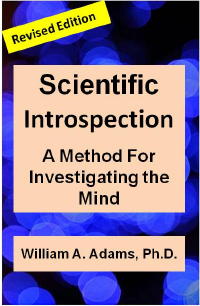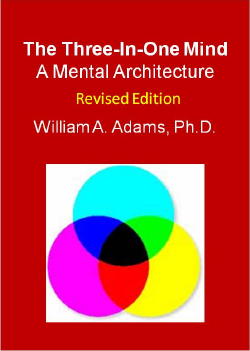 Bill Adams is a cognitive psychologist, an academic teacher and researcher. He taught at the University of Wisconsin, the University of Maryland-University College, the College of Idaho, Chapman University, and Brandman University. After years of teaching, he left the academic life for the computer industry, hoping to discover if the mind is like a computer (it isn’t). Then, following a lifetime of writing non-fiction, he has turned to writing fiction, as William A. Adams. His first novella, a suspense tale involving a rare prehistoric artifact is Hunter and Hunted. For more book information, sample chapter, and ordering, see http://billadamsphd.net/
Bill Adams is a cognitive psychologist, an academic teacher and researcher. He taught at the University of Wisconsin, the University of Maryland-University College, the College of Idaho, Chapman University, and Brandman University. After years of teaching, he left the academic life for the computer industry, hoping to discover if the mind is like a computer (it isn’t). Then, following a lifetime of writing non-fiction, he has turned to writing fiction, as William A. Adams. His first novella, a suspense tale involving a rare prehistoric artifact is Hunter and Hunted. For more book information, sample chapter, and ordering, see http://billadamsphd.net/
Arizona Mystery Writers is a great support group for beginning or experienced fiction writers. I joined because the mystery-suspense-thriller genres are well-defined, which is helpful for a new fiction writer, and because mystery writers are interesting people with a good sense of humor. (Notice the seamless transition from third person to first person! I couldn’t have done that a few years ago). My writing has evolved toward suspense, not whodunit so much as whydunit. Advice for ex-academic writers: There is zero transfer of skill, so be prepared to start over.
For more information, sample chapters, and ordering information, see http://billadamsphd.net/
Publications:
 Hunter and Hunted
Hunter and Hunted
Bridget Kemper, a Seattle businesswoman who hunts deer by archery for recreation, buys a prehistoric hunting artifact. But that does not establish her as a serious collector as she had hoped. Instead, she discovers the artifact is a forgery. She returns to the seller in Johannesburg only to find him murdered. Worse, somebody believes her artifact is genuine and wants it. She becomes the hunted. She could be the hunter if she knew who was after her, but her investigation is stymied when she is charged with the murder of the South African dealer. Can she beat extradition in time to find out who is trying to kill her and what happened to the real artifact?
 The Purpose of the Body
The Purpose of the Body
The body is not the mind, and the mind is not the body. What is the relationship between the mind, introspectively understood, and its extremely intimate partner, the body?
What if the apparently self-existent, biological body is actually a concept of the mind? From that confusion, guided by one’s community, the concept of the body is projected outward, away from subjectivity, then reified into a self-existent object, a fact of nature, which is how we think of it in common sense and in science.
If the physical body is just a mistaken idea, what is its purpose? Two physical bodies cannot be in the same place at the same time, so your body guarantees a mental unity that belongs to you. Without that guarantee, your mind would dissipate into all the others and you would cease to exist as an individual. In fact, that’s what happens when your body dies.
What of theory of evolution, according to which, physical bodies existed long before human minds? Some suggestions are offered in the direction of dealing with that problem. Consequences of re-thinking the relationship of mind and body in this way include a reconsideration of cognitive information processing, death, and metaphysics.
 Scientific Introspection
Scientific Introspection
Scientific Introspection calls for psychologists to use introspection to investigate the mind. What researchers do now is study the brain, and behavior, then from that, try to guess what the mind must be like. But why guess? Remarkably, we happen to have the ability to look directly into the workings of our own minds: introspection. As far as we know, we are the only animal on the planet that can do that. It is foolish not to use this amazing gift.
Scientific Introspection is an adjunct to traditional cognitive psychology and cognitive neurophysiology. There is no scientific way to observe the mind directly. Thoughts weigh nothing; ideas take up no space. The only way to observe the mind is through introspection. Scientific introspection supplements science with a genuine first-person methodology, so we can finally understand the mind.
The book includes a detailed description of Scientific Introspection applied. The reader can follow the procedure and confirm or disconfirm the findings. The demonstration shows how Scientific Introspection can be used as a shared investigative tool to produce consensus findings about how the mind works.
 The Three-In-One Mind
The Three-In-One Mind
The normal, adult, human mind is made up of three different streams of concurrent consciousness. “The mind” then, is not a single mental process but more like a string trio. Introspection seems to reveal only one stream of consciousness but that’s only because two of them are not susceptible to introspection. The single-process model of mind has a lot to answer for. We don’t understand our own motivation. We can’t really understand embodiment, nor why the body doesn’t always do what it is told. We don’t know what intuition is, or where creativity comes from. We can’t really explain memory, attention, or learning, or why we say things we don’t mean. Personality is a mystery. We don’t know what love is, how to get it, or why it goes wrong. We don’t even know why we do the things we do half the time. This book argues that a three way analysis of mind is the best explanation for how the mind works. It offers useful innovations that plausibly resolve many perplexing problems of psychology.
